15 Types Of BLUE BIRDS In Arizona (ID Guide With Photos)
Did you see a blue-colored bird in Arizona? In that case you’ll probably want to know what species you saw.
To help you identify the bird you saw, we’ll cover all the types of blue birds that can be seen in Arizona.
We’ll show you the birds of Arizona that are either entirely or partially blue, and will also cover where you can expect to find these birds.
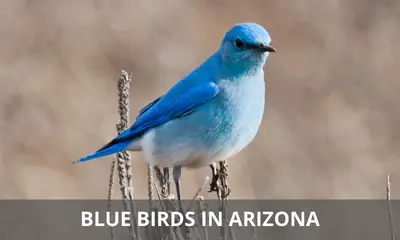
What types of birds are blue in Arizona?
The 15 types of blue-colored birds found in Arizona are:
- Western Bluebird
- Mountain Bluebird
- Eastern Bluebird (Azure Bluebird)
- Woodhouse’s Scrub Jay
- Steller’s Jay
- Pinyon Jay
- Mexican Jay
- Lazuli Bunting
- Indigo Bunting
- Blue-gray Gnatcatcher
- Barn Swallow
- Tree Swallow
- Purple Martin
- Belted Kingfisher
- Great Blue Heron
- Blue Grosbeak
Out of these 15 birds, only one species is entirely blue (the Indigo Bunting), while the others are partially blue birds.
Now let’s dive into the details, and take a closer look at each of these birds in order to get the full scoop:
Western Bluebird
Scientific name: Sialia mexicana
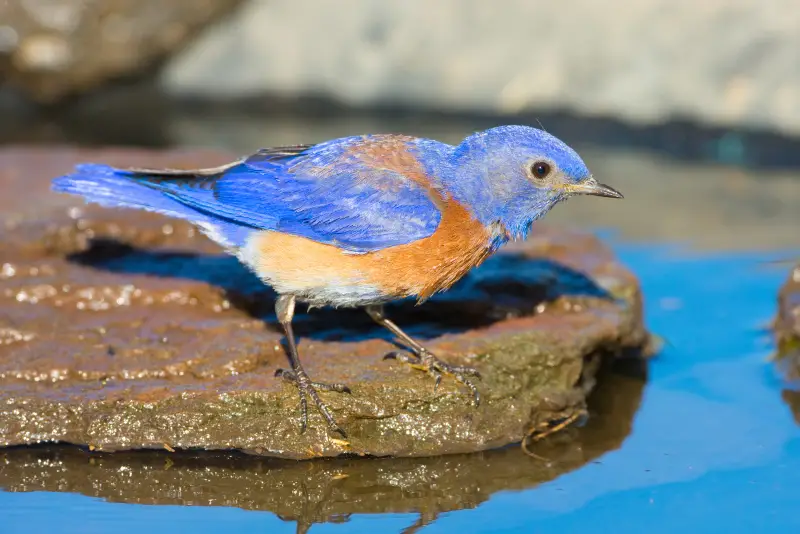
The Western Bluebird is the most common bluebird species found in Arizona.
It is a breeding bird and year-round resident in the northern half of Arizona, and also occurs in southern parts of the state during the winter season.
Male Western Bluebirds have a deep shade of blue on their heads and backs, which contrasts with reddish orange plumage on the chest.
Female and juvenile birds on the other hand, have more subdued hues, with gray-brown upperparts and a lighter gray underside.
While Western Bluebirds are migratory birds in northern parts of their range, they are permanent residents in the Grand Canyon state.
These birds nest in treeholes or nestboxes, but have suffered from the competition with House Sparrows and European Starlings, which are more aggressive and chase bluebirds away from their nest sites.
The population of Western Bluebirds underwent a dramatic decline at the end of last century, due to lack of nesting holes and competition with European Starlings.
However, thanks to the efforts of numerous Arizona citizens providing nest boxes for Western Bluebirds, these birds are a common sight in Arizona once more.
Mountain Bluebird
Scientific name: Sialia currucoides
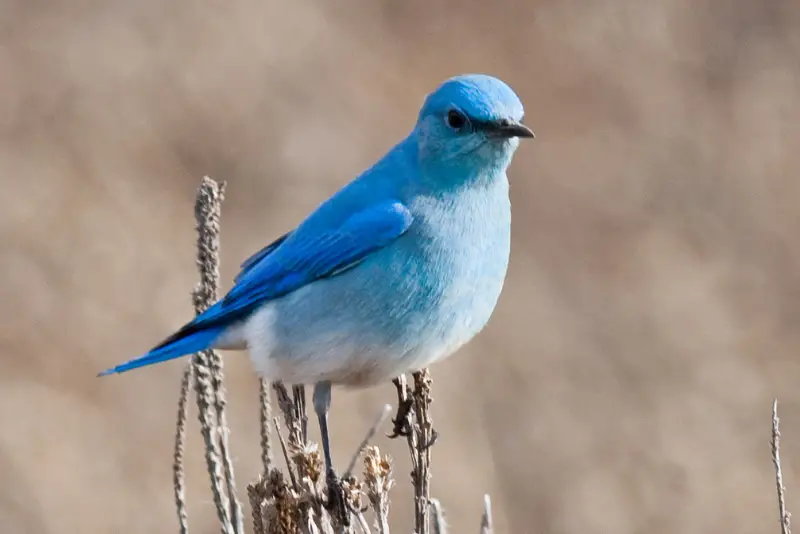
The Mountain Bluebird is generally found in more montane habitats than the former species, but the two types of bluebirds sometimes overlap in their distribution.
Adult males are almost entirely cerulean blue, except for their pale cream colored belly. The blue plumage is darker on the back, and lighter on the chest.
Females are buff gray, except for a light blue rump and wing feathers.
These birds with blue and white plumage breed in northern Arizona, and can be found there throughout the year. During winter they occur throughout the state, and sometimes visit bird feeders offering berries or mealworms.
Mountain Bluebirds readily accept nestboxes, and so can be attracted to nest in your backyard. However, you may need to put up several boxes, as they are often displaced by more aggressive bird species.
Eastern Bluebird (Azure Bluebird)
Scientific name: Sialia sialis
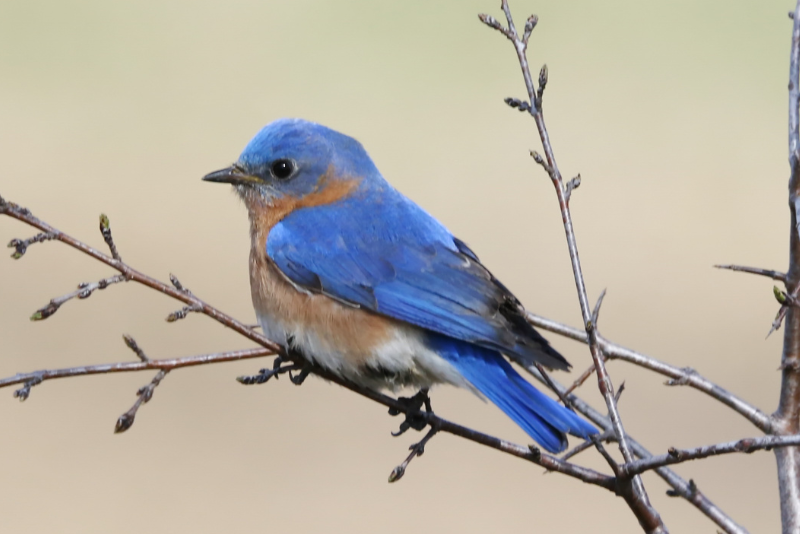
While the Eastern Bluebird is an eastern species, it also occurs in a small area of southeast Arizona, where it is a breeding bird and year-round resident.
Eastern Bluebirds in Arizona belong to the subspecies Sialia sialis fulva, which is also known as the Azure Bluebird.
The upperparts of adult males are a rich shade of admiral blue. This coloration also extends into their wings, tail, and the back of their heads.
The partial orange collar of males creates the impression of having a cap on their head. Males have a prominent rufous orange chest.
The upperparts of adult females have a more grayish-brown color. However, females also have a blue tail and wing feathers, as well as a rufous-orange chest and flanks.
It is a migratory bird in the northern part of its range, but can be seen year-round in Arizona. Northern populations winter in Mexico.
This bird nests in holes, and competes with House Sparrows and European Starlings for nesting sites.
During their fall migration, they can be seen in flocks that like to feed on fruits and berries.
While this bird species is a hole nester that originally used a Woodpecker nest cavity for its nestlings, it now readily accepts artificial nest sites for its brood.
You can attract these blue birds in Arizona to your backyard by offering mealworms at your bird feeder.
Woodhouse’s Scrub Jay
Scientific name: Aphelocoma woodhouseii
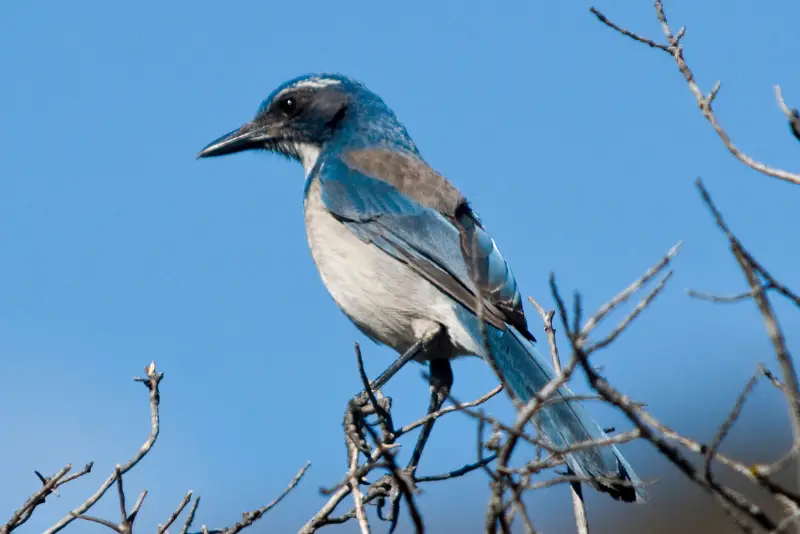
The Woodhouse’s Scrub Jay was called the Western Scrub Jay until a few years ago, and was thought to belong to a single species that occurs throughout the western United States.
However, in 2016 it was split into two different species, the California Scrub Jay (found along the Pacific Coast), and the Woodhouse’s Scrub Jay (found further inland). The population in Arizona belongs to the latter species.
This bird is the most widespread jay species in the Grand Canyon State, and is a common bird throughout Arizona, except for the Sonoran Desert.
Adult males and females look the same, and have an azure blue upper head, wings, and tail, as well as dark gray shoulders and a light gray belly. The largely blue body contrasts with a white throat streaked with gray.
These jays are year-round residents that can be encountered in a variety of lightly wooded habitats and scrub land.
Steller’s Jay
Scientific name: Cyanocitta stelleri
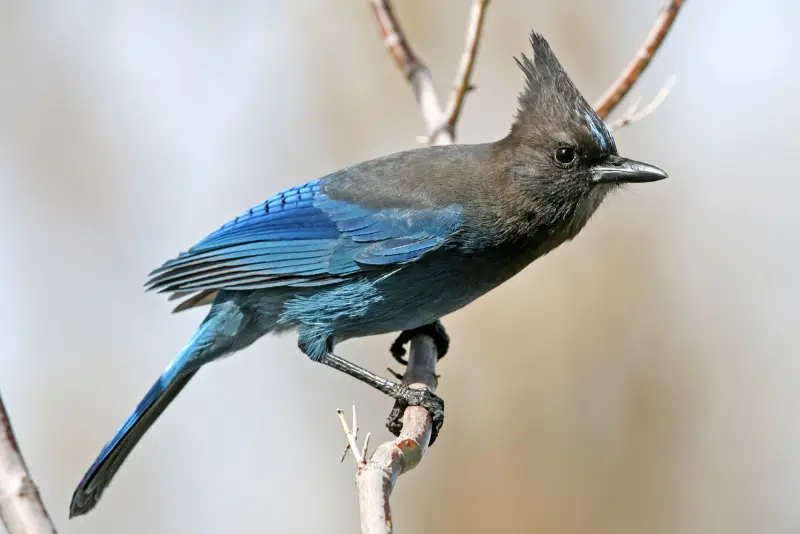
Steller’s Jay is a medium-sized member of the jay family, and is easily recognized due to the dark blue body combined with its striking crest.
It is a common breeding bird in northern Arizona, but is absent from the more arid areas in the south, including the Sonoran Desert.
Both males and females look similar, and have a dark gray to blackish head, nape, and upper back, while the rest of the body is dark admiral blue.
While it is found year-round within its breeding range, in some years Steller’s Jays undertake irruptive movements towards the south, and show up in areas where they normally don’t occur.
Pinyon Jay
Scientific name: Gymnorhinus cyanocephalus
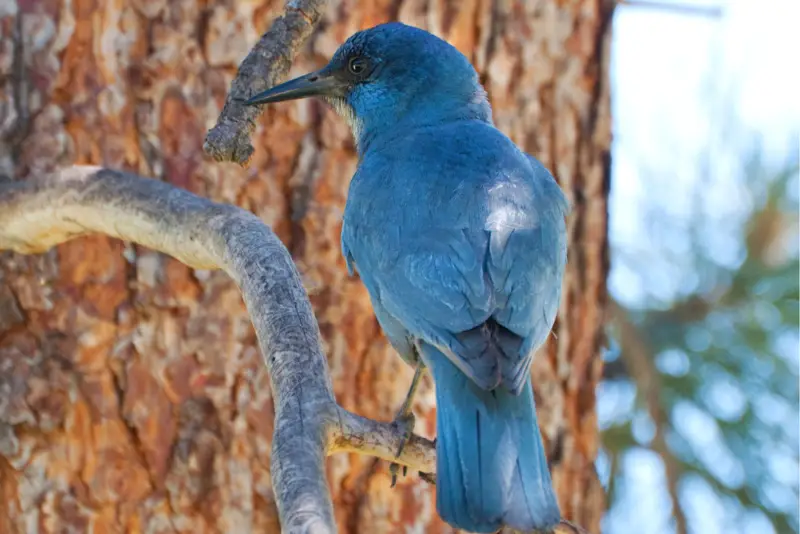
The Pinyon Jay is an almost entirely blue songbird that doesn’t look much like a jay, due to its slender body and thin bill.
Adult males and females look the same and are light blue all over, with the darkest hues found around the head region, and the palest on the belly.
The Pinyon Jay is a regular breeding bird in mountainous areas of northwestern Arizona.
However if you do find a Pinyon Jay, there are probably more of them nearby, as they like to nest in colonies containing dozens of pairs.
It feeds on pine seeds as well as insects and fruits depending on the season.
Mexican Jay
Scientific name: Aphelocoma wollweberi

The Mexican Jay is the fourth type of blue-colored jay found in Arizona, but is also the rarest in the state, and only occurs in a small part of southeastern Arizona.
It occurs in woodland consisting of pines, junipers and oaks, where they forage in flocks of up to more than 20 birds.
Interestingly, while these jays often overlap with other jay species in their range, they prefer different types of habitat, and thus don’t compete with each other.
Their main food source are acorns, which they store in large caches that can contain several thousand acorns.
Lazuli Bunting
Scientific name: Passerina amoena
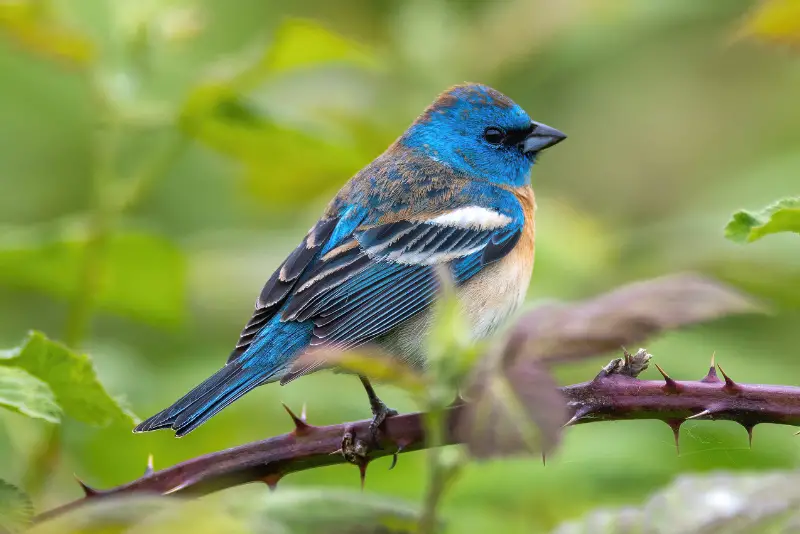
The Lazuli Bunting is a gorgeous songbird of the western United States that visits and breeds in northern Arizona during the summer.
The hood, neck, and rump of adult males are light blue, while the wings are dark gray with a white wingbar. Males also have a chestnut orange breast and a white belly throughout the summer months.
Females are buff-brown in color with black wings and a pale blue rump.
The Lazuli Bunting may be found in Arizona during the breeding season, which runs from May to August, before migrating to Mexico for the winter.
Indigo Bunting
Scientific name: Passerina cyanea
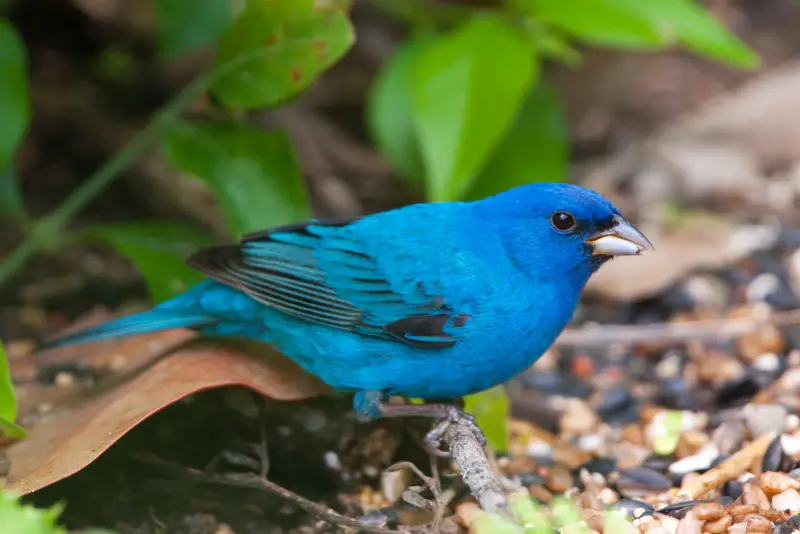
The Indigo Bunting is a strikingly colored small songbird. During the summer, the male is almost entirely indigo blue, except for darker brownish wingtips and tail feathers.
Females and juvenile birds are more inconspicuous, with light brown upperparts, and creamy white underparts.
The Indigo Bunting is relatively common in Arizona at forest edges, gardens, and parks, and will readily visit bird feeders that offer seeds.
This blue bird is most commonly seen at backyard bird feeders in spring, but not in summer, as it switches over from seeds to eating mostly insects during the summer.
During the breeding season, males of this bird can often be observed singing from a treetop perch.
This blue bird is a strict migrant, and is only found in Arizona during the summer. It winters in Central and South America, and migrates in small flocks during the fall migration.
Blue-gray Gnatcatcher
Scientific name: Polioptila caerulea
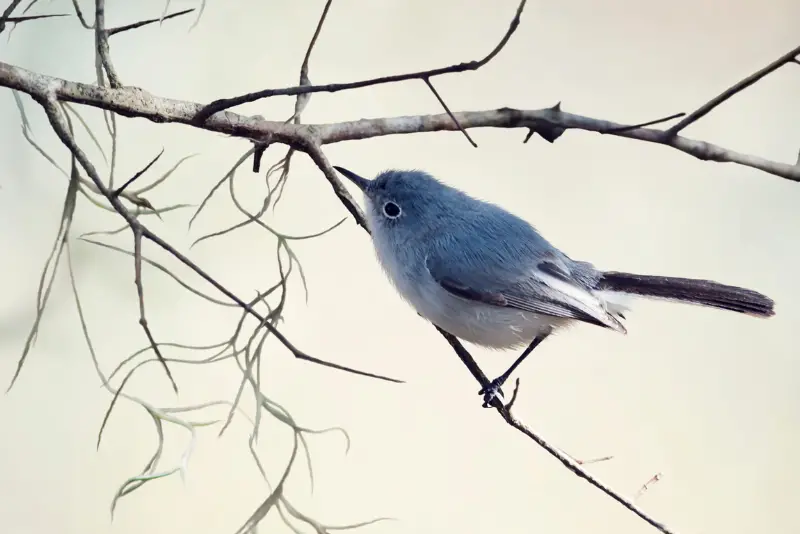
Except for its long tail, the Blue-gray Gnatcatcher looks a lot like a warbler.
The upperparts of adult males are blue-gray, while their underparts are a lighter gray. The tail is black with a white stripe at the margins.
Adult females and immature birds are rayish on top, and light gray underparts. The eye of both sexes has a white eyering.
It may be encountered as a breeding bird in the temperate regions of North America, predominantly from early May through August.
It is a partial migratory bird, with southeastern populations being year-round residents. Northern populations, however, spend the winter in the southern USA and Central America.
A great way to identify this bird is by its long tail that is often cocked upwards.
Barn Swallow
Scientific name: Hirundo rustica
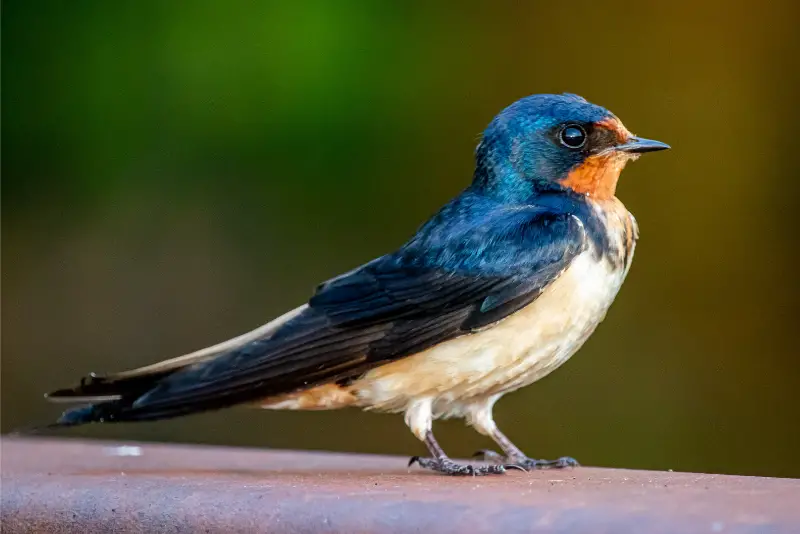
The Barn Swallow inhabits nearly all of North America south of the Arctic circle and may be found in a wide variety of habitats.
This bird has iridescent upperparts that shimmer in various shades of dark blue when the sunlight hits them.
Its underside is reddish-orange, including a chestnut orange forehead and throat, as well as a light reddish-orange belly.
The deeply forked tail of Barn Swallows is another great feature you can use to identify this bird.
However, keep in mind that immature barn swallows have a duller plumage than adults, as well as a shorter tail that is less forked.
The Barn Swallow used to nest in caves and hollow trees, but nowadays it prefers to do so beneath the overhangs of buildings and bridges, as well as inside barns (which explains how this bird got its name).
These Arizona swallows are still a reasonably common sight in most areas. However, the overall numbers of Barn Swallows have been steadily decreasing, especially in the northern section of their range.
This decline is likely a result of the loss of foraging areas and nesting opportunities.
The Barn Swallow feeds on flying insects, such as mosquitoes and flies, and catches them closer to the ground than other species of swallows. In its winter quarters this bird also feeds on termites.
It is a strictly migratory bird, and spends the winter in Central and Southern America.
Purple Martin
Scientific name: Progne subis

The Purple Martin is the largest martin in North America. The male is almost entirely dark purplish blue with an iridescent sheen. The wings and tail are black.
Juvenile birds and females are light gray on top, with beige white underparts. The male Purple Martin is the only martin species that doesn’t have a light colored belly.
While these blue-colored birds originally built their nest in tree cavities, they have switched over to using man-made nesting sites instead.
The Purple Martin likes to nest in colonies, which often comprise dozens of pairs. It is a skilled aerial hunter, and feeds mostly on dragonflies.
Similar to other species of swallows, the Purple Martin drinks in flight, by skimming the surface of a body of water.
This bird is a strictly migratory species and spends the winter in South America. It congregates in large roosts in fall, which fly south together.
The best way to attract these gorgeous blue birds to your yard is by putting up a Purple Martin house in your backyard,
Belted Kingfisher
Scientific name: Megaceryle alcyon

The Belted Kingfisher looks superficially similar to a Blue Jay, due to its grayish blue upperside.
However, the Belted Kingfisher is darker than a Jay, and is also more likely to be found close to water.
Adult male Belted Kingfishers are almost entirely teal blue on top, except for a white collar that separates the cap from the rest of the body.
They also have a grayish chest band, and a white belly. Females can be distinguished from males by their rufous orange flanks.
The Belted Kingfisher prefers habitats directly adjacent to lakes and rivers, where it hunts for fish by diving headfirst into the water.
This blue bird is a partial migratory bird, but can be seen year round in southern parts of its range, including Arizona.
During harsh winters, northern Belted Kingfishers migrate to southern parts of the United States.
This blue-colored bird of Arizona feeds almost exclusively on small fish, and is therefore rarely seen far away from water.
Great Blue Heron
Scientific name: Ardea herodias
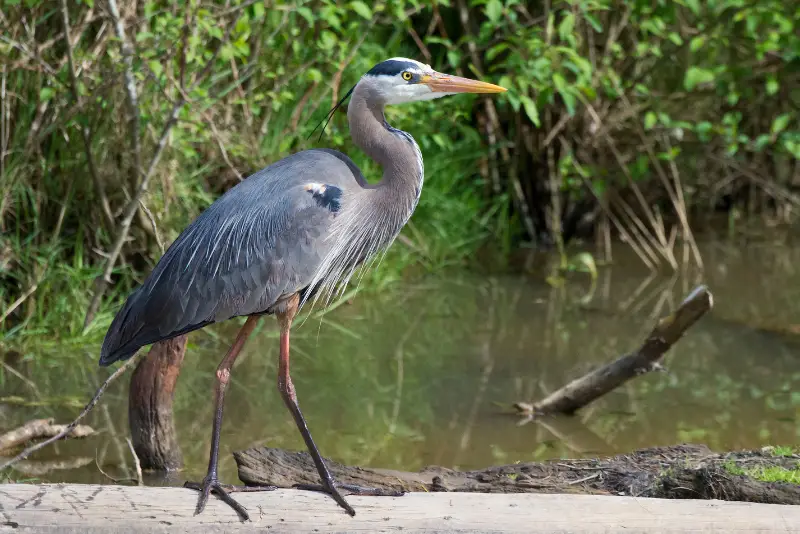
The Great Blue Heron is one of the most common herons in Arizona, where it can be seen year round.
This large Arizona bird has a wingspan of up to 6 feet. It is almost entirely blue gray, except for a white throat and eye stripe, as well as dark gray wing feathers.
This bird likes to hunt for small fish and other aquatic animals by wading in the shallows of lakes, marshes and ponds.
This bird waits patiently for a suitably sized fish to come close enough to be grabbed with its long, yellow bill.
This blue bird also forages on meadows, golf courses and grassy areas, where it stalks rodents. It is a non-migratory bird, and can be seen in Arizona all year round.
However, it requires open water in order to catch fish, and northern birds will fly to southern states if the winter is very cold.
Blue Grosbeak
Scientific name: Passerina caerulea

The Blue Grosbeak is a beautiful songbird that has a large beak shaped like a cone.
The adult males are almost entirely dark blue in color, except for two chestnut-brown wingbars and black feathers on their face.
Females, on the other hand, are brownish gray with pale underparts. This grosbeak is a breeding visitor throughout Arizona, but migrates to Central America to spend the winter.
The preferred habitat of this bird is shrubland and grassland interspersed with dense bushes.
What are the large blue birds in Arizona?
The large blue birds in Arizona are jays. The most widespread blue-colored jays in Arizona are Woodhouse’s Scrub Jays, though Steller’s Jays are also common in large parts of the state.
In some parts of the Grand Canyon State you could also be looking at either Pinyon Jays or Mexican jays, which are also blue colored, but not as common as the two previous species.
If you’re not sure which species of jay you saw, refer to our detailed ID guide above, which has photos of all these species.
If you enjoyed this article, check out our guide to the yellow birds of Arizona.
